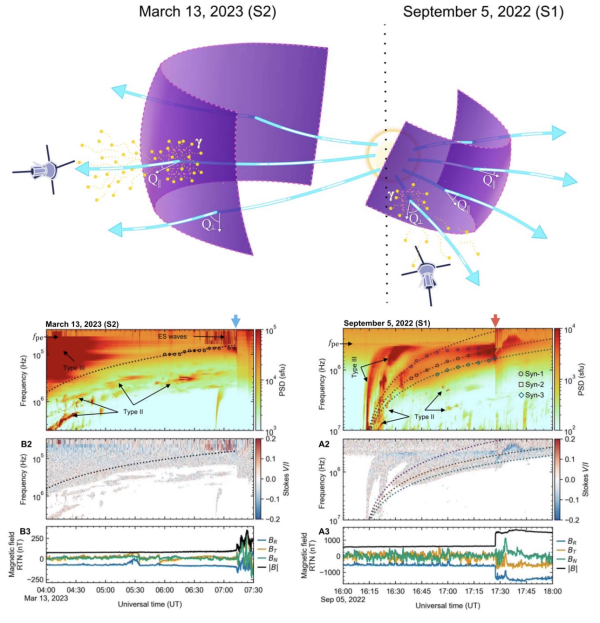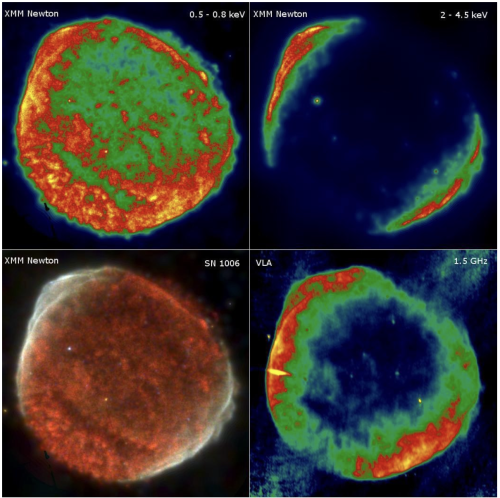Synchrotron Radiation and the Foundations for a Cosmic Bridge
| Nugget | |
|---|---|
| Number: | 502 |
| 1st Author: | Immanuel Jebaraj |
| 2nd Author: | |
| Published: | August 4, 2025 |
| Next Nugget: | Neupert Effect |
| Previous Nugget: | The Aulanier Effect: drifting footpoints of CME flux ropes |
Introduction
Synchrotron radiation is that twentieth-century physics that opened the high-energy Universe. Relativistic electrons spiraling in magnetic fields broadcast a broadband glow whose spectral features and polarization tell us about these electrons, the magnetic field, and the plasma they inhabit. That is how we have revealed shock physics in supernova remnants, jets, and clusters: from a spectrum we infer the nonthermal energy budget, from polarization we infer field geometry, and from spectral curvature we infer cutoffs and transport. For all that reach, a simple link between remote observations and in-situ measurements is missing and for which, we must look close to home. We had not, in our own heliosphere, understood how the fast electrons we measure at a traveling interplanetary shock actually relate to the synchrotron continuum recorded at that very place and time. Making that link matters, because this radiation is not an afterthought or merely a diagnostic. It is part of how a collisionless shock rearranges itself: the energy of the flow feeds secondary waves, which scatter and energize particles; the particles run up the ladder into a nonthermal tail, and that tail radiates via the synchrotron process. This light is the accounting ledger of that energy redistribution.
Making the Connection
With Parker Solar Probe we have now made the connection (Ref. [1]). Two fast shocks have swept over the spacecraft, one roughly aligned with the magnetic field, and one nearly perpendicular to it (Figure 1, top panel). During each event's passage, we recorded dynamic electric-field spectra and high-rate waveforms, and we measured energetic electrons at high energies in two viewing directions. In both encounters the spectra revealed a diffuse, broadband, self-absorbed continuum whose frequency slid toward the local plasma frequency as the shock neared the spacecraft (Figure 1 bottom panel). The waveforms above the plasma frequency propagated at near-light speed, identifying the emission as electromagnetic rather than electrostatic. Polarization drew a clean contrast: in the near-perpendicular case we detected circular polarization with the handedness expected; in the near-parallel case the signal arrived depolarized after passage through a strongly inhomogeneous, turbulent plasma that scrambles polarization before it reaches the observer. From the details we could infer that the far-field approximation had broken and that the spacecraft sat directly within the emitting/accelerating region.

The electrons tell the same story as the photons. Upstream of the perpendicular shock the spectrum tracked a power law only to about one MeV before steepening; at the highest energies the Sunward telescope outcounted the anti-Sun view by more than an order of magnitude, a clear anisotropy toward the approaching shock. Those are the signatures of limited pitch-angle scattering and inefficient acceleration into the strongly radiating range. Upstream of the parallel shock the spectrum maintained a single power law deep into the relativistic band, and the two views measured nearly the same intensities: a nearly isotropic population supported by robust upstream waves. Those are the conditions under which synchrotron radiation appears. When we compare the optically thin radio slope to the in-situ electron slope, and watch both evolve as the turnover approaches the local plasma frequency, the particle-photon relationship becomes explicit.
Why does this matter?
What PSP has detected is fully consistent with what astrophysicists have found in the case of asymmetric supernova remnants such as that of SN1006 (Figure 2), where the synchrotron emission is brightest from the quasi-parallel poles. The same physics that shapes spectra at our heliospheric scales can apply at parsec scales. Our near-Sun measurements thus give that framework a ground truth: they specify which geometries and local conditions actually deliver the relativistic electrons, and they show in the light how those electrons are distributed. Because the measurements are colocated and simultaneous, they close a longstanding heliophysics question with data. The data show directly that traveling interplanetary shocks near the Sun create relativistic electrons in situ and that those same electrons produce the synchrotron continua we observe.
Conclusions
These measurements tie relativistic electrons to their synchrotron emission at the same place and time near the Sun, establish a clear geometry dependence (near-parallel shocks produce stronger, harder, more isotropic electron populations than quasi-perpendicular shocks), and provide a local, testable template for the same fundamental processes invoked to explain synchrotron-bright shocks across astrophysics. That is our "bridge" here. It closes the observational loop between particles and photons in the inner heliosphere and anchors how we read spectra and polarization in remote systems using first-principles, co-located evidence.
We note that an earlier Nugget dealt with a different kind of bridge, also linking distinct worlds of research.
References
[1] "Direct Measurements of Synchrotron-emitting Electrons at Near-Sun Shocks"
